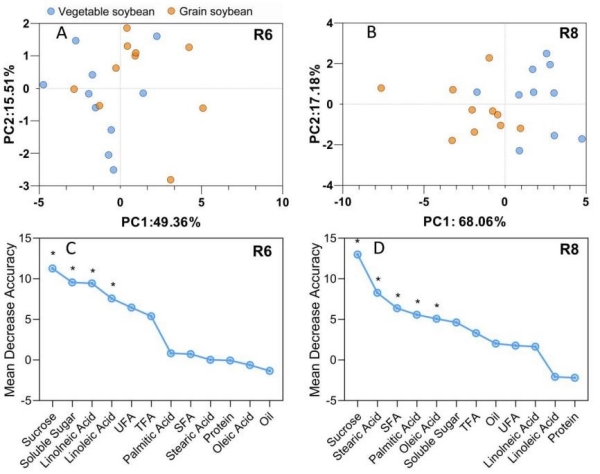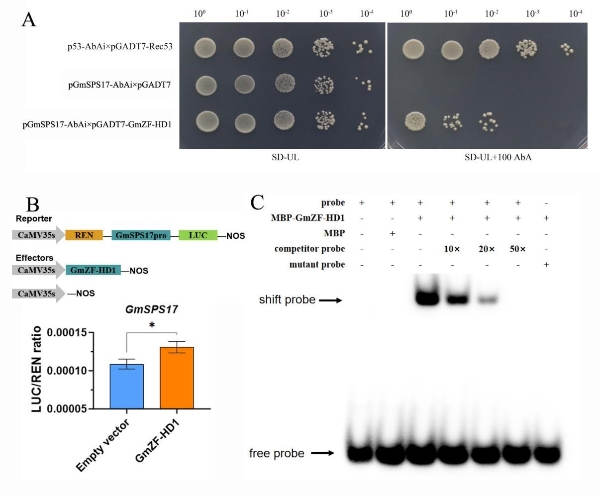Recently, a research team led by Prof. ZHANG Qiuying from the Northeast Institute of Geography and Agroecology, CAS, identified sucrose as a key quality trait that distinguishes two types of soybeans. The team also uncovered a molecular module regulating sucrose accumulation in soybean seeds, offering a novel theoretical basis for breeding fresh-consumption soybeans with elevated sugar content.
This work was published in Horticulture Research on 15 September 2025.
Soybean, a globally significant crop, can be categorized into two major types based on the harvest period: Vegetable soybean and grain soybean. Vegetable soybean, commonly known as “Maodou” is harvested at the fresh pod stage, while grain soybean is primarily used for food processing, oil extraction, and animal feed. Despite differences in harvest time and seed size, the nutritional differences between these two types are often overlooked in variety breeding. With the growing awareness of health, vegetable soybean is gaining increasing attention due to its high nutritional value. Therefore, in-depth research on the nutritional differences and regulatory mechanisms between vegetable soybean and grain soybean is of great significance for optimizing soybean variety breeding strategies and developing high-nutritional-value soybean varieties.
In this study, a comprehensive comparison of nutritional components was conducted on 10 vegetable soybean and 10 grain soybean varieties (lines). The results showed that vegetable soybean had significantly higher levels of sucrose, soluble sugar, and crude protein than grain soybean, while crude oil and total fatty acid content were relatively lower. In particular, vegetable soybean contained a higher proportion of unsaturated fatty acids, especially oleic acid, at the fresh pod stage. Through principal component analysis (PCA) and machine learning algorithms, it was found that there were significant differences in nutritional composition between vegetable soybean and grain soybean, and sucrose was identified as the key nutritional marker distinguishing edamame from grain soybean (Figure 1).

Figure 1. Screening of nutritional quality markers distinguishing vegetable soybean from grain soybean.
In addition, by integrating dynamic RNA-seq and weighted gene co-expression network analysis (WGCNA), the researchers further explored the gene modules associated with sucrose accumulation and identified GmSPS17 as the gene encoding sucrose phosphate synthase (SPS), as well as its upstream transcription factor GmZF-HD1. Further molecular experiments and genetic transformation experiments confirmed that GmZF-HD1 increases sucrose accumulation by directly activating the transcription of GmSPS17. In the soybean hairy root overexpression system, GmZF-HD1 significantly enhanced the expression of GmSPS17, thereby increasing sucrose accumulation. This study clarified that sucrose is the key nutritional marker distinguishing vegetable soybean from grain soybean and revealed the molecular mechanism by which GmZF-HD1 regulates sucrose accumulation through GmSPS17 (Figure 2). The research findings provide important guidance for the development of high-sugar edamame varieties.

Figure 2. Regulation of GmZF-HD1 on GmSPS17 expression.
This study was funded by the National Key R&D Program of China (2021YFD1201103-03), the Strategic Priority Research Program of Chinese Academy of Sciences (XDA28070402), and Heilongjiang Provincial Natural Science Foundation Outstanding Young Scholar Fund.
Key words: Soluble sugars, Protein, Fatty acids, GmSPS17 , GmZF-HD1
Contact:
Dr. LI Yansheng, Associate Professor
Northeast Institute of Geography and Agroecology, Key Laboratory of Mollisols Agroecology, Chinese Academy of Sciences, Harbin 150081, China
E-mail: liyansheng@iga.ac.cn
Reference:
Liu Changkai, Zhang Qiuying, Hu Yanfeng, Li Yansheng*, Liu Xiaobing. Sucrose as a Key Nutritional Marker Distinguishing Vegetable and Grain Soybeans, Regulated by GmZF-HD1 via GmSPS17 in Seeds. Horticulture Research, 2025. DOI: 10.1093/hr/uhaf242
https://academic.oup.com/hr/advance-article/doi/10.1093/hr/uhaf242/8254146?login=true.